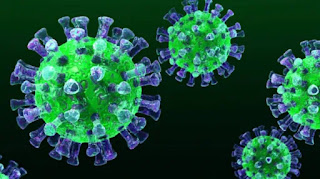The verdict is out - keep one’s immunity up, but libido down, save hugging and kissing till temperatures rise above 52 degrees celsius!
The chilling, though not necessary deadly, Coronavirus known as Covid 19
has arrived in India with several foreign returned individuals having tested
positive, and have already made contact and spread the virus to some.
Other than the precautions which all media is recommending – principal among
them is frequently washing hands with soap and water for 20 seconds in each
session, and avoiding touching ones eyes, nose and mouth, there is little else one can do. If one has huge fears, one may
confine oneself to home or banish fears and continue life as usual.
Though the possibility of contagion is high, statistics show that the
death rate is low, with probably only 1-2 % fatalitites. A heartening statistic
is that children are least likely to contract the virus, and for those below
the age of 29 years the fatality rate is as low as 0.3 %.
Dr. Naresh Trehan has given a comprehensive overview
Panic is unnecessary however precaution is important, according to him.
His prognosis can be read in link below:
A positive indication given by Dr. Trehan is that the virus does not
survive in temperatures above 35 degrees Celsius, and above 52 degrees it
destructs in 15 minutes.
Baba Ramdev has recommended combating the threat through turning to ancient Indian practices of Ayurved and Yog. Prevention by building up one’s immunity.
He advices healthy lifestyle, eating right, practicing yogasaans and in
particular
partaking of
giloy (tinospora cordifolia) which has powerful immunity building characteristic.
 Giloy
Giloy can be had on its own or combined with 4 more ingredients (turmeric, ginger, holy basil & pepper) to make a brew
below is the recipe:
giloy (tinospora cordifolia) – 2 six inch sticks – ground
haldi (turmeric) - 1 inch piece or 2 gms powder

adrakh (ginger) - 1 inch piece
or 2 gms powder
tulsi (holy basil) - 8 leaves

kali mirch (black pepper) - 2 peppercorns
Boil all ingredients in one glass water till water is reduced to ¼ quantity,
will become a thickish brew.
Can have this brew 2-3 times a day
Pranayam
Practice daily the following 5
bhastrikaa pranayam भस्त्रिका प्राणायाम – inhale and exhale deeply and forcefully
kapaal bhaati pranayam कपाल भाति प्राणायाम – inhale deeply, exhale
forcefully
anulom vilom pranayam अनुलोम-विलोम प्राणायाम
– breathing alternatively from each nostril, hold breath in between each
inhalation and exhalation
bhraamari pranayam भ्रामरी प्राणायाम
– inhaling and exhaling accompanied by making humming bee sound at back of
throat
Omkaar pranayam ओंकार प्राणायाम – inhale deeply, exhale making long Om sound. Exhalation
should be double duration of inhalation
Yog
Additionally practice daily
Surya Namaskaar + 5-7
yogaasan in standing, sitting and supine
positions
(caution: people suffering from ailments like hypertension, heart disease etc. must practise pranayam & yog with necessary precautions)
Check out Baba Ramdev’s recommendations in link below – too many ads.,
but do persist, advice is sound, maybe this scare will encourage veering towards a
healthier lifestyle:






























